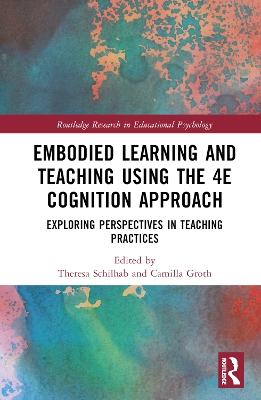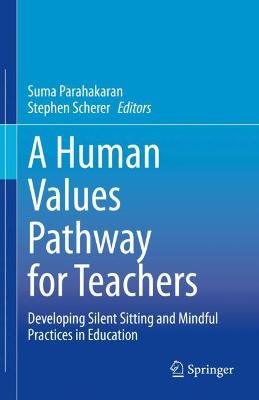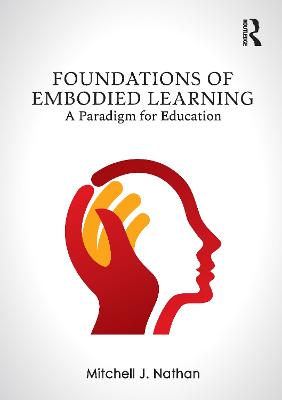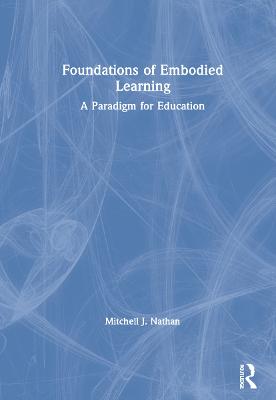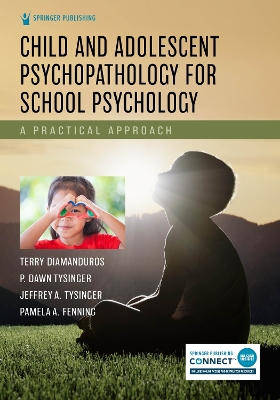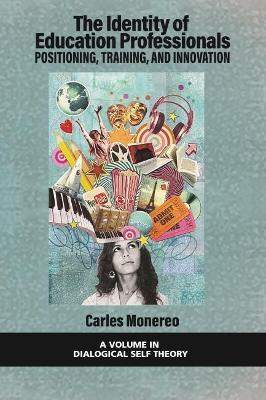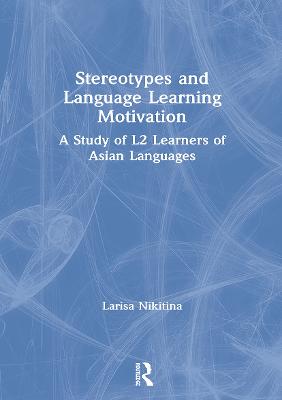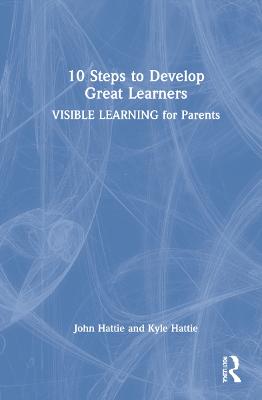Human Values Pathway for Teachers
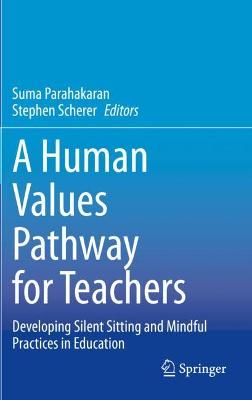 portes grátis
portes grátis
Human Values Pathway for Teachers
Developing Silent Sitting and Mindful Practices in Education
Scherer, Stephen; Parahakaran, Suma
Springer Verlag, Singapore
03/2022
177
Mole
Inglês
9789811602023
15 a 20 dias
308
Silent Sitting & Story Telling: The Power Of Oral Traditions
Lalini Reddy, Dharma Naidoo Magendri Perumal, Pat Reddy
South African Institute of Sathya Sai Education, Cape Town, South Africa
reddyl@cput.ac.za, lalinisai@gmail.com
Many of our current education systems globally are in need of re-vitalisation in teaching and learning methods and techniques that inspire students to learn. It seems poignant for us to return to age-old traditions and practices which instilled interest and passion in the education and development of our forefathers. Two such techniques are discussed in this chapter, namely: silent sitting or meditation, and storytelling. The impact of these techniques on children and teachers will be discussed. This chapter explores the roots of silent sitting and takes an in depth look at why story-telling, an age-old oral tradition, continues to work so effectively for passing on information from generation to generation in the context of education. Silent sitting and storytelling are presented as teaching or transformation techniques that can inspire children from a young age towards both academic excellence and character development. The techniques may be used as standalone methods using age appropriate methods and stories. A variety of examples of powerful stories for human transformation are presented showing how they foster positive morals and values in students. Silent sitting techniques are demonstrated using a variety of techniques that take less than 10 minute to practice. to lead the child gradually inward increasing awareness of his or her inner self.
Chapter 2
Silent sitting, Mindfulness and Meditation: Building more resilience and self-awareness in teachers teaching in a Malaysian school
Dr Suma Parahakaran
Sathya Sai Academy, Malaysia (Certified Trainer)
Education Consultant
Wawasan Open University (Tutor, Course Assessor and Module writer)
sap1@tutor.wou.edu.my
This chapter will explain teachers' use of silent sitting as a pedagogical practice. The chapter provides other teaching pedagogies which can be used along with their own teaching style. The difference between mindfulness, meditation and silent sitting is explained to further clarify silent sitting as a teaching technique. A tool kit is provided to support teachers to implement silent sitting in the classroom. Teachers' ability to channel their thoughts so that they use their awareness to be self -resilient in different situations is explained in this chapter. Along with teachers' practice, self- awareness of their own actions and monitoring their own actions and thoughts become crucial drivers to their teaching techniques. The Human Values Integrated Model (Jumsai, 2004) is explained briefly to enhance the understanding of the learner's mind. The five basic, universally shared values and their relationship to teaching practices are also explored so that teachers are able to contribute to a child's wholesome living and learning experience. This chapter supports that teachers' gain of insight into the self and increase in resilience are enhanced as they practice silent sitting along with their classroom.
Chapter 3
Mindfulness as Resilience: Applying African-Centered Psychology in Educating Youth of Color in the United States
Dr. Stephen Scherer
Research Consultant- Virginia State University,
Clinical Health Psychologist- RISE Center for Behavioral Health, New York
sscherer@vsu.edu, scherer.stphn@gmail.com,
Cheryl P. Talley, Ph.D Department of Psychology, Virginia State University
ctalley@vsu.edu
This chapter investigates the use of mindfulness as one strategy that increases resilience. We will also present techniques and case studies to support building mindfulness practice into the K-12 classroom curricula. Researchers exploring the impact of institutional barriers associated with race and class distinctions in the United States have shown that historical social, economic, and political forces contribute to the challenges and demands of high-stress, high risk, and under-resourced communities in which many students live. It is important to consider that students attending under-resourced schools demonstrate a great deal of positive traits that are also conducive to high academic achievement. For those students that aspire for and eventually attain college degrees, there appears to be a constellation of traits that can be grouped together under the term "resilience." Generally speaking, investigations of U.S. mainland youth of color from under-resourced communities are done without consideration of the impact of risk factors and resilient traits that contribute to positive academic outcomes. This lack of acknowledging or valuing resilience compromises the study of marginalized groups by framing legitimate coping strategies or methods as deviant, pathological, and deficient instead of resilient. As a skill, mindfulness can be effectively taught in classroom settings and when included in an academic intervention, mindfulness practice strengthens emotional and behavioral self-regulation and results in higher grades and academic success.
Chapter 4
Humanising Education through Moral Education and Silent visualisations: The Caring Way
Vishalache Balakrishnan, PhD
Faculty of Education
University of Malaya
Malaysia
visha@um.edu.my
In the current digital world, every aspect of education has some elements of technology. Teaching and learning becomes very complex with the use of technology. The speed of changes in content and pedagogy is also increasing and driving education forward rapidly. Currently, success is based on how well students perform on their examinations. In many schools and higher learning institutions, we are missing the integration of people from different backgrounds which has caused education to stifle and feel like a mechanical process. Preschool children are forced to spend hours studying for a supposed early head start. By the time they are in secondary schools, students become burnt out or overwhelmed. Some even to the extent of taking their own lives because they cannot keep up with parental pressure for excellence in education. To ensure that the digital education era does not eliminate the humanities in education, there are special needs to ensure the humanising of education. Using Nodding's suggestion on the caring approach, subject areas across curricula can be molded into humanized and dynamic processes, characterized by the Moral Education pedagogy. Moral Education is a subject that aims to develop students into individuals who have integrity and noble values, high moral standards based on universal values founded on moral principles, which contribute towards the unity, prosperity and wellbeing of the country as well as global society. Through certain pedagogies in Moral Education such as visualisation and silent learning, students would be able to get into self-reflection. They would be in a better position to decide based on the moral choices available in moral dilemmas that they face at interpersonal and intrapersonal levels.
Chapter 5
The impact of silent sitting on Chinese teachers' problems
Margaret Taplin, (Dr) and Li Lingli
Centre for Research and Development in Values Education, South China Normal University, Guangzhou, China
To address problems with teacher morale, this study investigated some Chinese teachers' perceptions of the impact of silent sitting on their professional and personal problems. Independent samples t-tests indicated perceived changes in the seriousness of problems including student behaviour, excessive workload, exhaustion, feeling angry, doubting their sense of mission, and personal health. Follow-up interviews revealed that they attributed this improvement to the silent sitting strategies they had been taught. Two possible explanations emerged; that the use of the strategies changed children's behaviours, which changed the teachers' coping, and that the strategies empowered the teachers to look at their problems differently.
Chapter 6
Silent sitting and Attention for child development: Teachers' perceptions in a Primary School in Malaysia
Dr Suma Parahakaran
Sathya Sai Academy, Malaysia (Certified Trainer)
Education Consultant
Wawasan Open University (Tutor, Course Assessor and Module writer)
sap1@tutor.wou.edu.my
This chapter is related to teachers' perception of implementing silent sitting in their classrooms. A brief introduction is provided to explain why this is an important pedagogy used in Education in Human Values. The need for directing attention and focus to learning and the environment students interact requires the child to be fully in the present. Silent sitting helps the child to progress in directing the necessary attention to the required object of learning. Neuroscience has helped to support the understanding to a certain extent of how the brain processes both attention and awareness of the child's surroundings. The journey helps the outward and the inner growth of the child as they increase their awareness and reinforce positive thoughts. The benefits are discussed as part of a study. The study sample consists of thirteen teachers from a school in Malaysia. Workshops were developed and conducted to support teachers so that they can help students to concentrate and visualize using short passages. The study confirmed that teachers require support for their own practice and implementation in their own classrooms. A follow up workshop was conducted and teachers responded with positive responses. Participants responded that they had new ideas coming in, solutions to problems they had thought over, controlling of anger etc. This chapter informs readers that although the journey is challenging, the benefits of silent sitting from teachers' responses demonstrate that the impact of silent sitting reduces stress.
Chapter 7
Child Development in the digital era: Silent sitting and mindfulness technique for information processing
Dr Suma Parahakaran
Sathya Sai Academy, Malaysia (Certified Trainer)
Education Consultant
Wawasan Open University (Tutor, Course Assessor and Module writer)
sap1@tutor.wou.edu.my
This chapter focuses on the need to integrate silent sitting as an important technique for young children. Experiments conducted in neuroscience reveal that the practice of silence or mindfulness, promote well-being in children. Clinical findings have also revealed that meditation has reduced a number of psychological symptoms. Young children who are indulging in the use of too much technology are distracted. These have implications on their learning. Children do not pay attention for in depth learning as they are multi -tasking more, moving from one type of task to another. According to reviews of studies from cognitive science and experiments with neural networks, the brain has to reorient itself thus taxing neural capacities. Such short intensive tasks causes cognitive overload which in turn reduces the brains ability to process information and store it. This interrupted learning has impact on long term memory and child development. The use of silent sitting helps children recoup their energy and the chapter provides details of experiences from perspectives of teachers from direct implementation of silent sitting for learning.
Chapter 8
Silent Sitting, meditation and benefits.
Sangita (Sandy) Naidu , M.Ed, PhD scholar
University of New England
Australia
snaidu4@myune.edu.au
Silent sitting as a form of mindfulness practice stems out from an ancient concept of meditation, which is now being rigorously explored in medical and educational fields. The countless benefits of meditation outweigh arguments against it. While meditation has been defined in many ways such as breath control, chanting and cognitive mindfulness training, silent sitting is another aspect of it. Silent sitting enables the pause between the thoughts to be longer, to be able to experience stillness and ultimately to experience inner tranquility. As a primary school teacher at an independent school in New South Wales Australia, I introduced silent sitting in the form of meditation on light, which was conducted every morning at school assembly. While no scientific studies had been conducted at the school, the teachers found that students were calmer and more focused. The benefits of meditation in various fields is still being explored. One such field is in reducing anxiety and stress in children. This chapter will explore the many ways in which silent sitting has been practiced, the benefits of silent sitting and the experiences of the writer in teaching and practicing stillness.
Chapter 9
Silent sitting as part of Education in Human Values program for Community development
Gayatree Sambhoo
EHV Trainer for Community Groups in Mauritius
gayeetreesambhoo@gmail.com
The UN 17 Sustainable Development Goals and the 2030 Agenda explicitly recognize the importance of Peace in sustainable Community Development. Since the pendulum swings outwards, the outer world is the reflection of the inner world. If peace is instilled within the core of the being, peace will permeate the entire world. There has been a recent significant collapse of the family unit which is the building block of society. Consequently, Mauritius, a beautiful island with a population of 1.4 million people, has not been spared. To address the drastic and conspicuous rise in conflicts and family values in our multi ethnic fabric of society, a national, sustainable, and integrated community development Education in Human Values (EHV) program called "Strengthening Values in Family Life" was developed and deployed. The various innovative and creative silent sitting techniques implemented emerged as one of the most effective, powerful and impactful technique in the whole project. Hence, this chapter explores the experiences and practices of our community outreach programme teachers. They have recorded positive attitude and behavioural changes, enhanced academic performance and inner peace of our students. Police statistics noted a stark reduction of vandalism, alcohol /drug addiction and crime rate in the village of intervention. Parents, teachers and community leaders share outcomes and evidences relating to the significant role of silent sitting towards self-transformation.
Chapter 10
A Southeast Asian Case Study of teachers practice with Ethics and Values based S.T.E.M education: Why silence and mindfulness matters
Professor Murali Raman
CEO of Sathya Sai Academy
Prof. Dr. Murali Raman, the Dean of Faculty of Management (FOM)
Malaysia
Dr Suma Parahakaran
Sathya Sai Academy, Malaysia (Certified Trainer)
Education Consultant
Wawasan Open University (Tutor, Course Assessor and Module writer)
Malaysia
sap1@tutor.wou.edu.my
Silent sitting and mindfulness have been discussed in psychology, neurosciences and physiology. However the importance of using the silent sitting technique as a practice to enhance reflection in STEM education is discussed in this chapter. A workshop conducted with teachers and educators in CoSMeD 2017 , Penang, Malaysia ( integrating ethics and values into S.T.E.M education) revealed that teachers and educators are able to conceptualise new ways of learning, thinking and implementing in their own field using their discriminatory faculties regardless of the subjects they teach. The first part of the chapter stresses the importance of new ways of thinking in education which can help sustain the earth for the future generation. The second part of the chapter introduces the ideas of experiential theory developed by David Kolb and the relationship to the different types of contextual knowledge as explained by the Ex- Vice Chancellor of the Sathya Sai Institute of Higher Learning. A practice called as Ceiling on desires program when implemented with silent sitting helps build reflective capacities in children. The relationship of the different aspects of the contextual knowledge and the learner's faculties of the mind are discussed.
Silent Sitting & Story Telling: The Power Of Oral Traditions
Lalini Reddy, Dharma Naidoo Magendri Perumal, Pat Reddy
South African Institute of Sathya Sai Education, Cape Town, South Africa
reddyl@cput.ac.za, lalinisai@gmail.com
Many of our current education systems globally are in need of re-vitalisation in teaching and learning methods and techniques that inspire students to learn. It seems poignant for us to return to age-old traditions and practices which instilled interest and passion in the education and development of our forefathers. Two such techniques are discussed in this chapter, namely: silent sitting or meditation, and storytelling. The impact of these techniques on children and teachers will be discussed. This chapter explores the roots of silent sitting and takes an in depth look at why story-telling, an age-old oral tradition, continues to work so effectively for passing on information from generation to generation in the context of education. Silent sitting and storytelling are presented as teaching or transformation techniques that can inspire children from a young age towards both academic excellence and character development. The techniques may be used as standalone methods using age appropriate methods and stories. A variety of examples of powerful stories for human transformation are presented showing how they foster positive morals and values in students. Silent sitting techniques are demonstrated using a variety of techniques that take less than 10 minute to practice. to lead the child gradually inward increasing awareness of his or her inner self.
Chapter 2
Silent sitting, Mindfulness and Meditation: Building more resilience and self-awareness in teachers teaching in a Malaysian school
Dr Suma Parahakaran
Sathya Sai Academy, Malaysia (Certified Trainer)
Education Consultant
Wawasan Open University (Tutor, Course Assessor and Module writer)
sap1@tutor.wou.edu.my
This chapter will explain teachers' use of silent sitting as a pedagogical practice. The chapter provides other teaching pedagogies which can be used along with their own teaching style. The difference between mindfulness, meditation and silent sitting is explained to further clarify silent sitting as a teaching technique. A tool kit is provided to support teachers to implement silent sitting in the classroom. Teachers' ability to channel their thoughts so that they use their awareness to be self -resilient in different situations is explained in this chapter. Along with teachers' practice, self- awareness of their own actions and monitoring their own actions and thoughts become crucial drivers to their teaching techniques. The Human Values Integrated Model (Jumsai, 2004) is explained briefly to enhance the understanding of the learner's mind. The five basic, universally shared values and their relationship to teaching practices are also explored so that teachers are able to contribute to a child's wholesome living and learning experience. This chapter supports that teachers' gain of insight into the self and increase in resilience are enhanced as they practice silent sitting along with their classroom.
Chapter 3
Mindfulness as Resilience: Applying African-Centered Psychology in Educating Youth of Color in the United States
Dr. Stephen Scherer
Research Consultant- Virginia State University,
Clinical Health Psychologist- RISE Center for Behavioral Health, New York
sscherer@vsu.edu, scherer.stphn@gmail.com,
Cheryl P. Talley, Ph.D Department of Psychology, Virginia State University
ctalley@vsu.edu
This chapter investigates the use of mindfulness as one strategy that increases resilience. We will also present techniques and case studies to support building mindfulness practice into the K-12 classroom curricula. Researchers exploring the impact of institutional barriers associated with race and class distinctions in the United States have shown that historical social, economic, and political forces contribute to the challenges and demands of high-stress, high risk, and under-resourced communities in which many students live. It is important to consider that students attending under-resourced schools demonstrate a great deal of positive traits that are also conducive to high academic achievement. For those students that aspire for and eventually attain college degrees, there appears to be a constellation of traits that can be grouped together under the term "resilience." Generally speaking, investigations of U.S. mainland youth of color from under-resourced communities are done without consideration of the impact of risk factors and resilient traits that contribute to positive academic outcomes. This lack of acknowledging or valuing resilience compromises the study of marginalized groups by framing legitimate coping strategies or methods as deviant, pathological, and deficient instead of resilient. As a skill, mindfulness can be effectively taught in classroom settings and when included in an academic intervention, mindfulness practice strengthens emotional and behavioral self-regulation and results in higher grades and academic success.
Chapter 4
Humanising Education through Moral Education and Silent visualisations: The Caring Way
Vishalache Balakrishnan, PhD
Faculty of Education
University of Malaya
Malaysia
visha@um.edu.my
In the current digital world, every aspect of education has some elements of technology. Teaching and learning becomes very complex with the use of technology. The speed of changes in content and pedagogy is also increasing and driving education forward rapidly. Currently, success is based on how well students perform on their examinations. In many schools and higher learning institutions, we are missing the integration of people from different backgrounds which has caused education to stifle and feel like a mechanical process. Preschool children are forced to spend hours studying for a supposed early head start. By the time they are in secondary schools, students become burnt out or overwhelmed. Some even to the extent of taking their own lives because they cannot keep up with parental pressure for excellence in education. To ensure that the digital education era does not eliminate the humanities in education, there are special needs to ensure the humanising of education. Using Nodding's suggestion on the caring approach, subject areas across curricula can be molded into humanized and dynamic processes, characterized by the Moral Education pedagogy. Moral Education is a subject that aims to develop students into individuals who have integrity and noble values, high moral standards based on universal values founded on moral principles, which contribute towards the unity, prosperity and wellbeing of the country as well as global society. Through certain pedagogies in Moral Education such as visualisation and silent learning, students would be able to get into self-reflection. They would be in a better position to decide based on the moral choices available in moral dilemmas that they face at interpersonal and intrapersonal levels.
Chapter 5
The impact of silent sitting on Chinese teachers' problems
Margaret Taplin, (Dr) and Li Lingli
Centre for Research and Development in Values Education, South China Normal University, Guangzhou, China
To address problems with teacher morale, this study investigated some Chinese teachers' perceptions of the impact of silent sitting on their professional and personal problems. Independent samples t-tests indicated perceived changes in the seriousness of problems including student behaviour, excessive workload, exhaustion, feeling angry, doubting their sense of mission, and personal health. Follow-up interviews revealed that they attributed this improvement to the silent sitting strategies they had been taught. Two possible explanations emerged; that the use of the strategies changed children's behaviours, which changed the teachers' coping, and that the strategies empowered the teachers to look at their problems differently.
Chapter 6
Silent sitting and Attention for child development: Teachers' perceptions in a Primary School in Malaysia
Dr Suma Parahakaran
Sathya Sai Academy, Malaysia (Certified Trainer)
Education Consultant
Wawasan Open University (Tutor, Course Assessor and Module writer)
sap1@tutor.wou.edu.my
This chapter is related to teachers' perception of implementing silent sitting in their classrooms. A brief introduction is provided to explain why this is an important pedagogy used in Education in Human Values. The need for directing attention and focus to learning and the environment students interact requires the child to be fully in the present. Silent sitting helps the child to progress in directing the necessary attention to the required object of learning. Neuroscience has helped to support the understanding to a certain extent of how the brain processes both attention and awareness of the child's surroundings. The journey helps the outward and the inner growth of the child as they increase their awareness and reinforce positive thoughts. The benefits are discussed as part of a study. The study sample consists of thirteen teachers from a school in Malaysia. Workshops were developed and conducted to support teachers so that they can help students to concentrate and visualize using short passages. The study confirmed that teachers require support for their own practice and implementation in their own classrooms. A follow up workshop was conducted and teachers responded with positive responses. Participants responded that they had new ideas coming in, solutions to problems they had thought over, controlling of anger etc. This chapter informs readers that although the journey is challenging, the benefits of silent sitting from teachers' responses demonstrate that the impact of silent sitting reduces stress.
Chapter 7
Child Development in the digital era: Silent sitting and mindfulness technique for information processing
Dr Suma Parahakaran
Sathya Sai Academy, Malaysia (Certified Trainer)
Education Consultant
Wawasan Open University (Tutor, Course Assessor and Module writer)
sap1@tutor.wou.edu.my
This chapter focuses on the need to integrate silent sitting as an important technique for young children. Experiments conducted in neuroscience reveal that the practice of silence or mindfulness, promote well-being in children. Clinical findings have also revealed that meditation has reduced a number of psychological symptoms. Young children who are indulging in the use of too much technology are distracted. These have implications on their learning. Children do not pay attention for in depth learning as they are multi -tasking more, moving from one type of task to another. According to reviews of studies from cognitive science and experiments with neural networks, the brain has to reorient itself thus taxing neural capacities. Such short intensive tasks causes cognitive overload which in turn reduces the brains ability to process information and store it. This interrupted learning has impact on long term memory and child development. The use of silent sitting helps children recoup their energy and the chapter provides details of experiences from perspectives of teachers from direct implementation of silent sitting for learning.
Chapter 8
Silent Sitting, meditation and benefits.
Sangita (Sandy) Naidu , M.Ed, PhD scholar
University of New England
Australia
snaidu4@myune.edu.au
Silent sitting as a form of mindfulness practice stems out from an ancient concept of meditation, which is now being rigorously explored in medical and educational fields. The countless benefits of meditation outweigh arguments against it. While meditation has been defined in many ways such as breath control, chanting and cognitive mindfulness training, silent sitting is another aspect of it. Silent sitting enables the pause between the thoughts to be longer, to be able to experience stillness and ultimately to experience inner tranquility. As a primary school teacher at an independent school in New South Wales Australia, I introduced silent sitting in the form of meditation on light, which was conducted every morning at school assembly. While no scientific studies had been conducted at the school, the teachers found that students were calmer and more focused. The benefits of meditation in various fields is still being explored. One such field is in reducing anxiety and stress in children. This chapter will explore the many ways in which silent sitting has been practiced, the benefits of silent sitting and the experiences of the writer in teaching and practicing stillness.
Chapter 9
Silent sitting as part of Education in Human Values program for Community development
Gayatree Sambhoo
EHV Trainer for Community Groups in Mauritius
gayeetreesambhoo@gmail.com
The UN 17 Sustainable Development Goals and the 2030 Agenda explicitly recognize the importance of Peace in sustainable Community Development. Since the pendulum swings outwards, the outer world is the reflection of the inner world. If peace is instilled within the core of the being, peace will permeate the entire world. There has been a recent significant collapse of the family unit which is the building block of society. Consequently, Mauritius, a beautiful island with a population of 1.4 million people, has not been spared. To address the drastic and conspicuous rise in conflicts and family values in our multi ethnic fabric of society, a national, sustainable, and integrated community development Education in Human Values (EHV) program called "Strengthening Values in Family Life" was developed and deployed. The various innovative and creative silent sitting techniques implemented emerged as one of the most effective, powerful and impactful technique in the whole project. Hence, this chapter explores the experiences and practices of our community outreach programme teachers. They have recorded positive attitude and behavioural changes, enhanced academic performance and inner peace of our students. Police statistics noted a stark reduction of vandalism, alcohol /drug addiction and crime rate in the village of intervention. Parents, teachers and community leaders share outcomes and evidences relating to the significant role of silent sitting towards self-transformation.
Chapter 10
A Southeast Asian Case Study of teachers practice with Ethics and Values based S.T.E.M education: Why silence and mindfulness matters
Professor Murali Raman
CEO of Sathya Sai Academy
Prof. Dr. Murali Raman, the Dean of Faculty of Management (FOM)
Malaysia
Dr Suma Parahakaran
Sathya Sai Academy, Malaysia (Certified Trainer)
Education Consultant
Wawasan Open University (Tutor, Course Assessor and Module writer)
Malaysia
sap1@tutor.wou.edu.my
Silent sitting and mindfulness have been discussed in psychology, neurosciences and physiology. However the importance of using the silent sitting technique as a practice to enhance reflection in STEM education is discussed in this chapter. A workshop conducted with teachers and educators in CoSMeD 2017 , Penang, Malaysia ( integrating ethics and values into S.T.E.M education) revealed that teachers and educators are able to conceptualise new ways of learning, thinking and implementing in their own field using their discriminatory faculties regardless of the subjects they teach. The first part of the chapter stresses the importance of new ways of thinking in education which can help sustain the earth for the future generation. The second part of the chapter introduces the ideas of experiential theory developed by David Kolb and the relationship to the different types of contextual knowledge as explained by the Ex- Vice Chancellor of the Sathya Sai Institute of Higher Learning. A practice called as Ceiling on desires program when implemented with silent sitting helps build reflective capacities in children. The relationship of the different aspects of the contextual knowledge and the learner's faculties of the mind are discussed.

